Virtue Ethics and Corruption
VerifiedAdded on 2022/11/16
|5
|1009
|57
AI Summary
This document discusses the impact of virtue ethics on corruption. It covers the Stanford prison experiment, Milgram's obedience experiment, and the Theological Seminary Experiment. It also explores the situationist theory and the debate between Harman and Doris. Additionally, it defines co-optation, incrementalism, compromise, and coercion as forms of corruption. References are included.
Contribute Materials
Your contribution can guide someone’s learning journey. Share your
documents today.
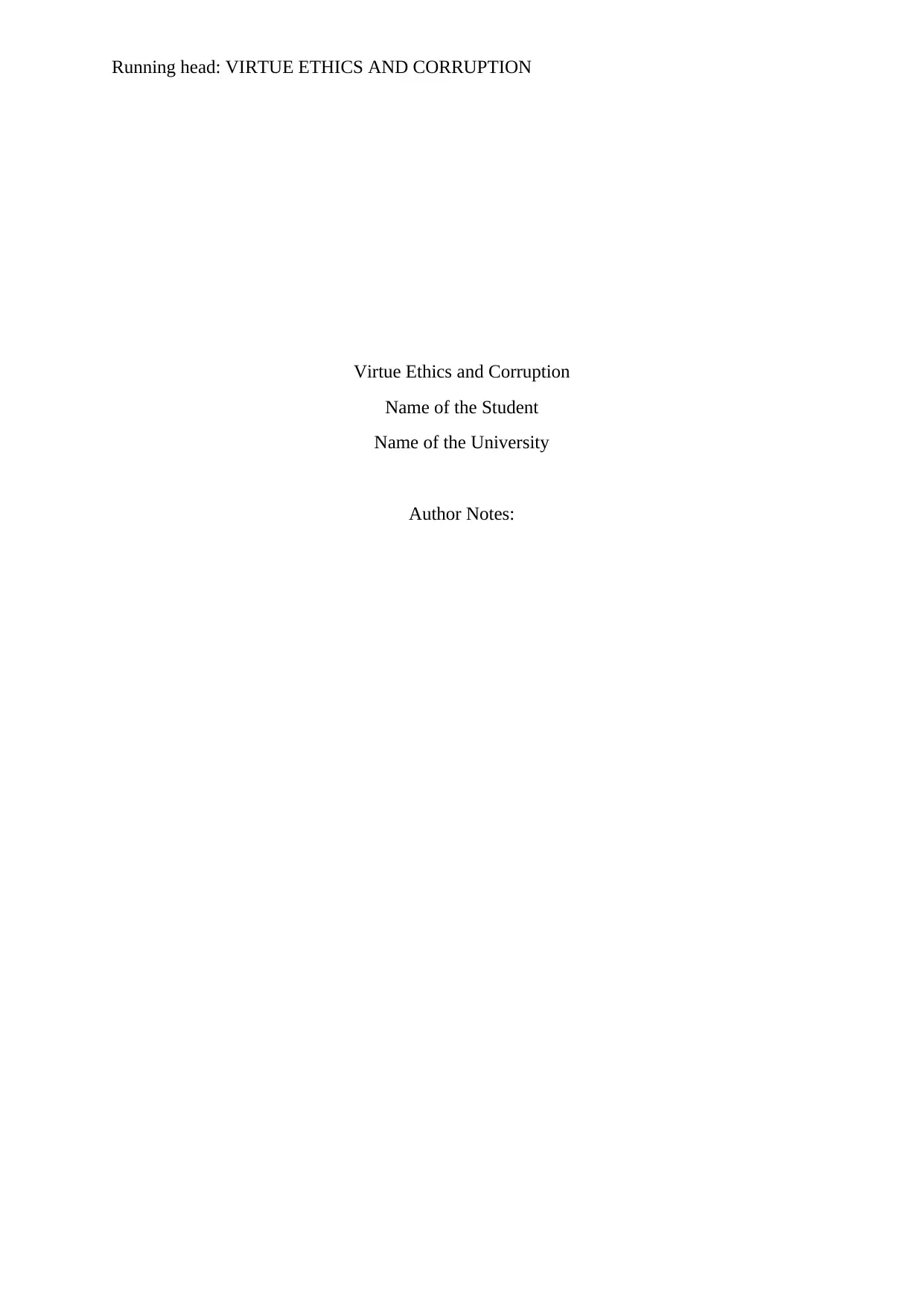
Running head: VIRTUE ETHICS AND CORRUPTION
Virtue Ethics and Corruption
Name of the Student
Name of the University
Author Notes:
Virtue Ethics and Corruption
Name of the Student
Name of the University
Author Notes:
Secure Best Marks with AI Grader
Need help grading? Try our AI Grader for instant feedback on your assignments.
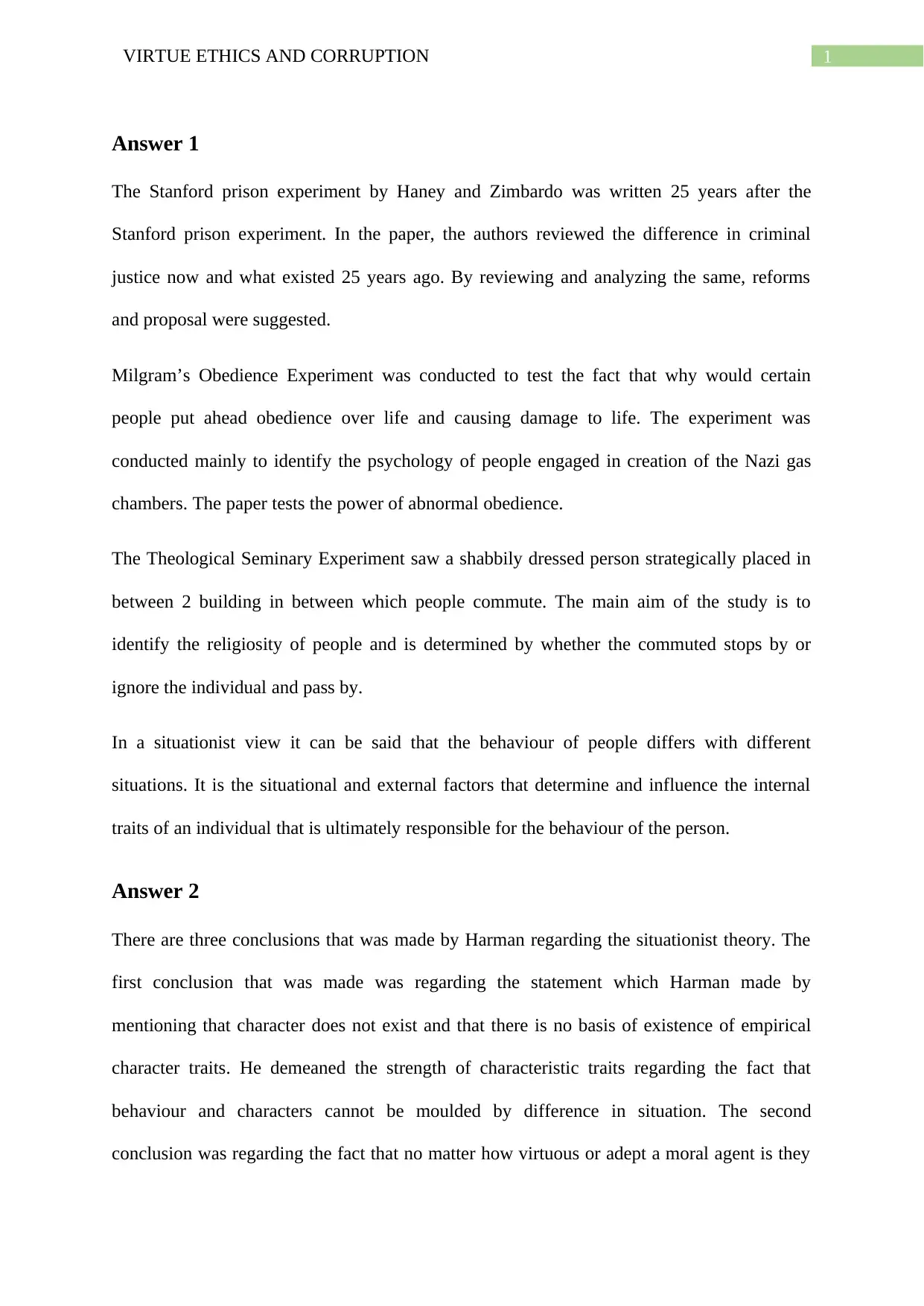
1VIRTUE ETHICS AND CORRUPTION
Answer 1
The Stanford prison experiment by Haney and Zimbardo was written 25 years after the
Stanford prison experiment. In the paper, the authors reviewed the difference in criminal
justice now and what existed 25 years ago. By reviewing and analyzing the same, reforms
and proposal were suggested.
Milgram’s Obedience Experiment was conducted to test the fact that why would certain
people put ahead obedience over life and causing damage to life. The experiment was
conducted mainly to identify the psychology of people engaged in creation of the Nazi gas
chambers. The paper tests the power of abnormal obedience.
The Theological Seminary Experiment saw a shabbily dressed person strategically placed in
between 2 building in between which people commute. The main aim of the study is to
identify the religiosity of people and is determined by whether the commuted stops by or
ignore the individual and pass by.
In a situationist view it can be said that the behaviour of people differs with different
situations. It is the situational and external factors that determine and influence the internal
traits of an individual that is ultimately responsible for the behaviour of the person.
Answer 2
There are three conclusions that was made by Harman regarding the situationist theory. The
first conclusion that was made was regarding the statement which Harman made by
mentioning that character does not exist and that there is no basis of existence of empirical
character traits. He demeaned the strength of characteristic traits regarding the fact that
behaviour and characters cannot be moulded by difference in situation. The second
conclusion was regarding the fact that no matter how virtuous or adept a moral agent is they
Answer 1
The Stanford prison experiment by Haney and Zimbardo was written 25 years after the
Stanford prison experiment. In the paper, the authors reviewed the difference in criminal
justice now and what existed 25 years ago. By reviewing and analyzing the same, reforms
and proposal were suggested.
Milgram’s Obedience Experiment was conducted to test the fact that why would certain
people put ahead obedience over life and causing damage to life. The experiment was
conducted mainly to identify the psychology of people engaged in creation of the Nazi gas
chambers. The paper tests the power of abnormal obedience.
The Theological Seminary Experiment saw a shabbily dressed person strategically placed in
between 2 building in between which people commute. The main aim of the study is to
identify the religiosity of people and is determined by whether the commuted stops by or
ignore the individual and pass by.
In a situationist view it can be said that the behaviour of people differs with different
situations. It is the situational and external factors that determine and influence the internal
traits of an individual that is ultimately responsible for the behaviour of the person.
Answer 2
There are three conclusions that was made by Harman regarding the situationist theory. The
first conclusion that was made was regarding the statement which Harman made by
mentioning that character does not exist and that there is no basis of existence of empirical
character traits. He demeaned the strength of characteristic traits regarding the fact that
behaviour and characters cannot be moulded by difference in situation. The second
conclusion was regarding the fact that no matter how virtuous or adept a moral agent is they
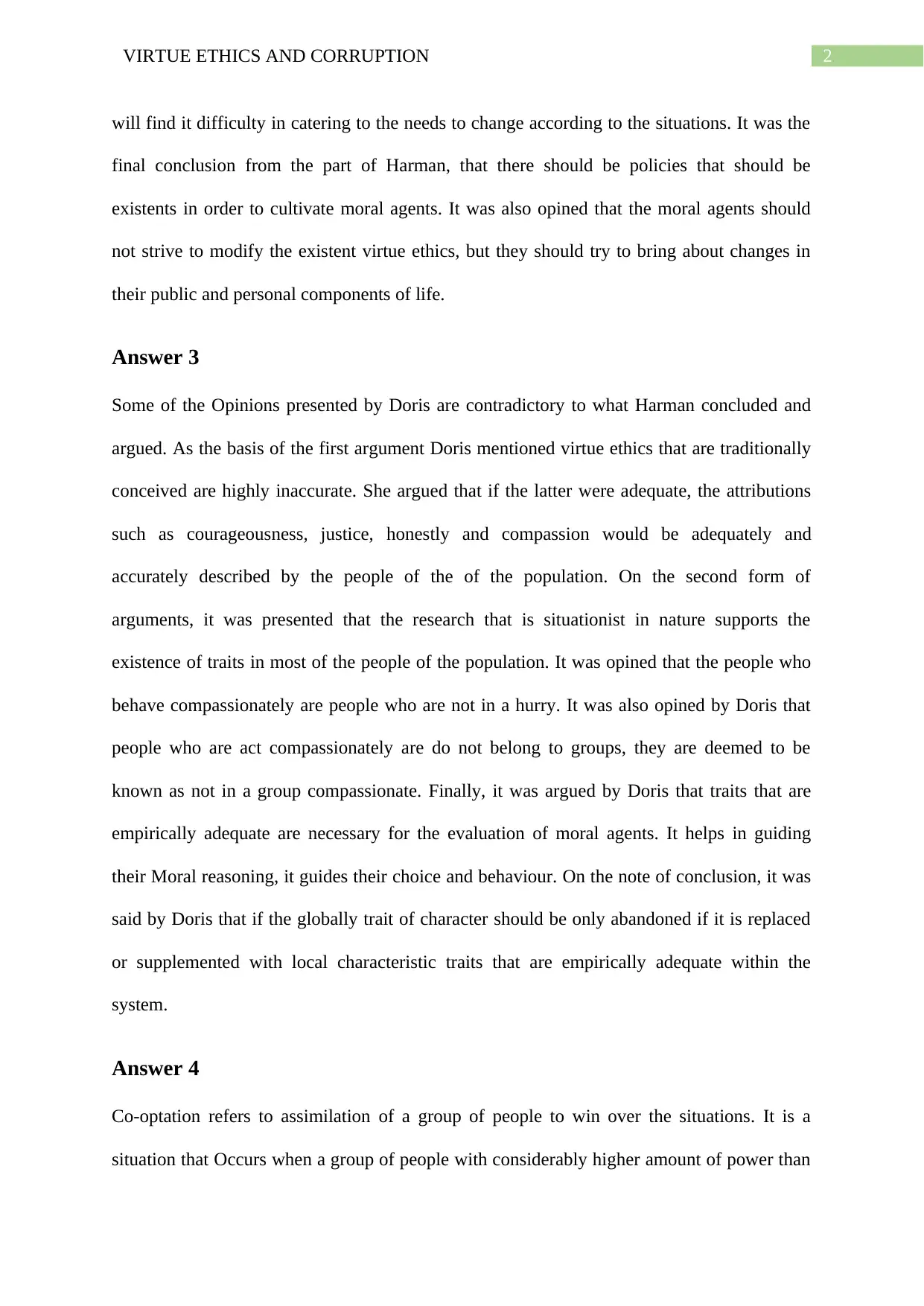
2VIRTUE ETHICS AND CORRUPTION
will find it difficulty in catering to the needs to change according to the situations. It was the
final conclusion from the part of Harman, that there should be policies that should be
existents in order to cultivate moral agents. It was also opined that the moral agents should
not strive to modify the existent virtue ethics, but they should try to bring about changes in
their public and personal components of life.
Answer 3
Some of the Opinions presented by Doris are contradictory to what Harman concluded and
argued. As the basis of the first argument Doris mentioned virtue ethics that are traditionally
conceived are highly inaccurate. She argued that if the latter were adequate, the attributions
such as courageousness, justice, honestly and compassion would be adequately and
accurately described by the people of the of the population. On the second form of
arguments, it was presented that the research that is situationist in nature supports the
existence of traits in most of the people of the population. It was opined that the people who
behave compassionately are people who are not in a hurry. It was also opined by Doris that
people who are act compassionately are do not belong to groups, they are deemed to be
known as not in a group compassionate. Finally, it was argued by Doris that traits that are
empirically adequate are necessary for the evaluation of moral agents. It helps in guiding
their Moral reasoning, it guides their choice and behaviour. On the note of conclusion, it was
said by Doris that if the globally trait of character should be only abandoned if it is replaced
or supplemented with local characteristic traits that are empirically adequate within the
system.
Answer 4
Co-optation refers to assimilation of a group of people to win over the situations. It is a
situation that Occurs when a group of people with considerably higher amount of power than
will find it difficulty in catering to the needs to change according to the situations. It was the
final conclusion from the part of Harman, that there should be policies that should be
existents in order to cultivate moral agents. It was also opined that the moral agents should
not strive to modify the existent virtue ethics, but they should try to bring about changes in
their public and personal components of life.
Answer 3
Some of the Opinions presented by Doris are contradictory to what Harman concluded and
argued. As the basis of the first argument Doris mentioned virtue ethics that are traditionally
conceived are highly inaccurate. She argued that if the latter were adequate, the attributions
such as courageousness, justice, honestly and compassion would be adequately and
accurately described by the people of the of the population. On the second form of
arguments, it was presented that the research that is situationist in nature supports the
existence of traits in most of the people of the population. It was opined that the people who
behave compassionately are people who are not in a hurry. It was also opined by Doris that
people who are act compassionately are do not belong to groups, they are deemed to be
known as not in a group compassionate. Finally, it was argued by Doris that traits that are
empirically adequate are necessary for the evaluation of moral agents. It helps in guiding
their Moral reasoning, it guides their choice and behaviour. On the note of conclusion, it was
said by Doris that if the globally trait of character should be only abandoned if it is replaced
or supplemented with local characteristic traits that are empirically adequate within the
system.
Answer 4
Co-optation refers to assimilation of a group of people to win over the situations. It is a
situation that Occurs when a group of people with considerably higher amount of power than
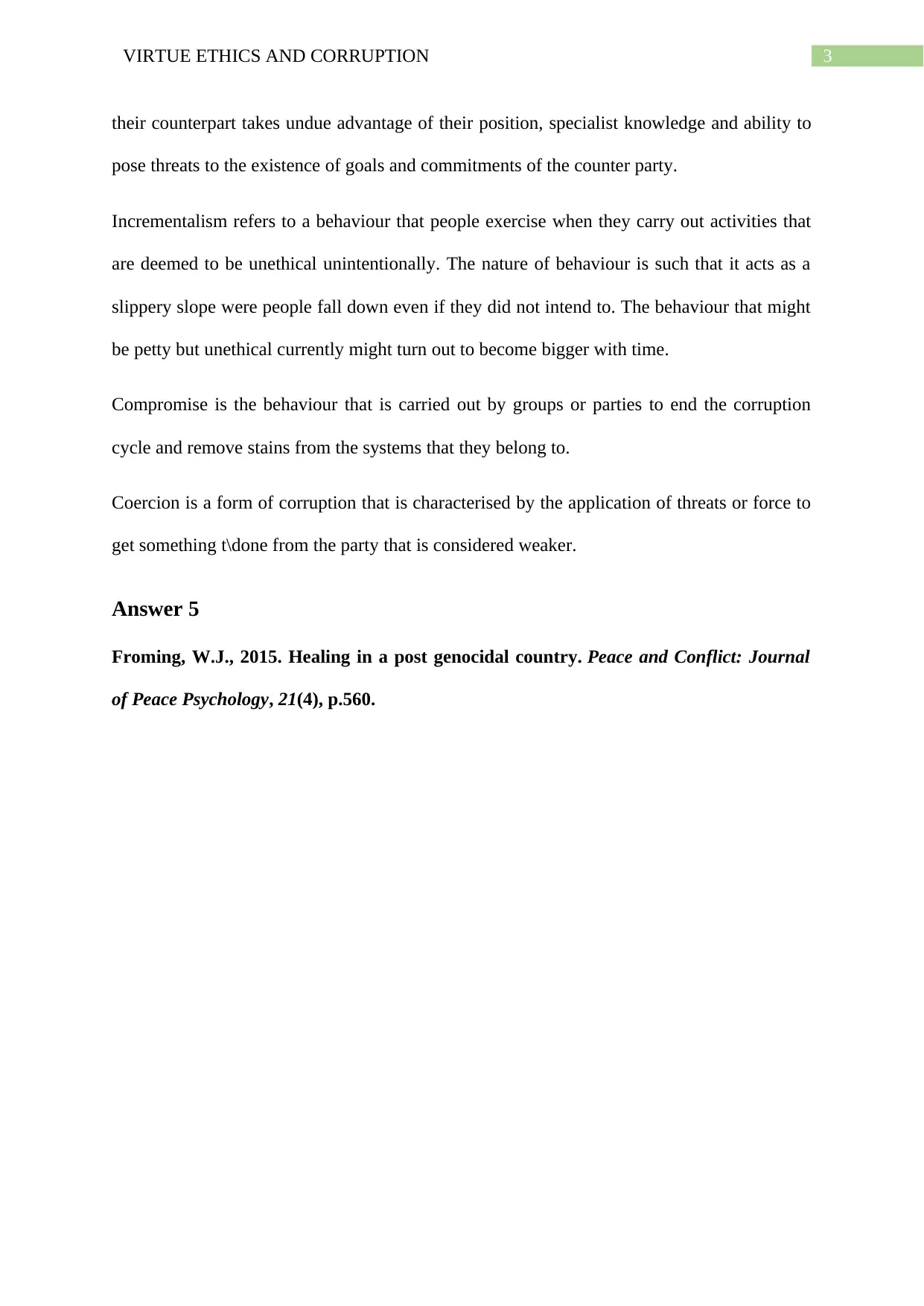
3VIRTUE ETHICS AND CORRUPTION
their counterpart takes undue advantage of their position, specialist knowledge and ability to
pose threats to the existence of goals and commitments of the counter party.
Incrementalism refers to a behaviour that people exercise when they carry out activities that
are deemed to be unethical unintentionally. The nature of behaviour is such that it acts as a
slippery slope were people fall down even if they did not intend to. The behaviour that might
be petty but unethical currently might turn out to become bigger with time.
Compromise is the behaviour that is carried out by groups or parties to end the corruption
cycle and remove stains from the systems that they belong to.
Coercion is a form of corruption that is characterised by the application of threats or force to
get something t\done from the party that is considered weaker.
Answer 5
Froming, W.J., 2015. Healing in a post genocidal country. Peace and Conflict: Journal
of Peace Psychology, 21(4), p.560.
their counterpart takes undue advantage of their position, specialist knowledge and ability to
pose threats to the existence of goals and commitments of the counter party.
Incrementalism refers to a behaviour that people exercise when they carry out activities that
are deemed to be unethical unintentionally. The nature of behaviour is such that it acts as a
slippery slope were people fall down even if they did not intend to. The behaviour that might
be petty but unethical currently might turn out to become bigger with time.
Compromise is the behaviour that is carried out by groups or parties to end the corruption
cycle and remove stains from the systems that they belong to.
Coercion is a form of corruption that is characterised by the application of threats or force to
get something t\done from the party that is considered weaker.
Answer 5
Froming, W.J., 2015. Healing in a post genocidal country. Peace and Conflict: Journal
of Peace Psychology, 21(4), p.560.
Secure Best Marks with AI Grader
Need help grading? Try our AI Grader for instant feedback on your assignments.
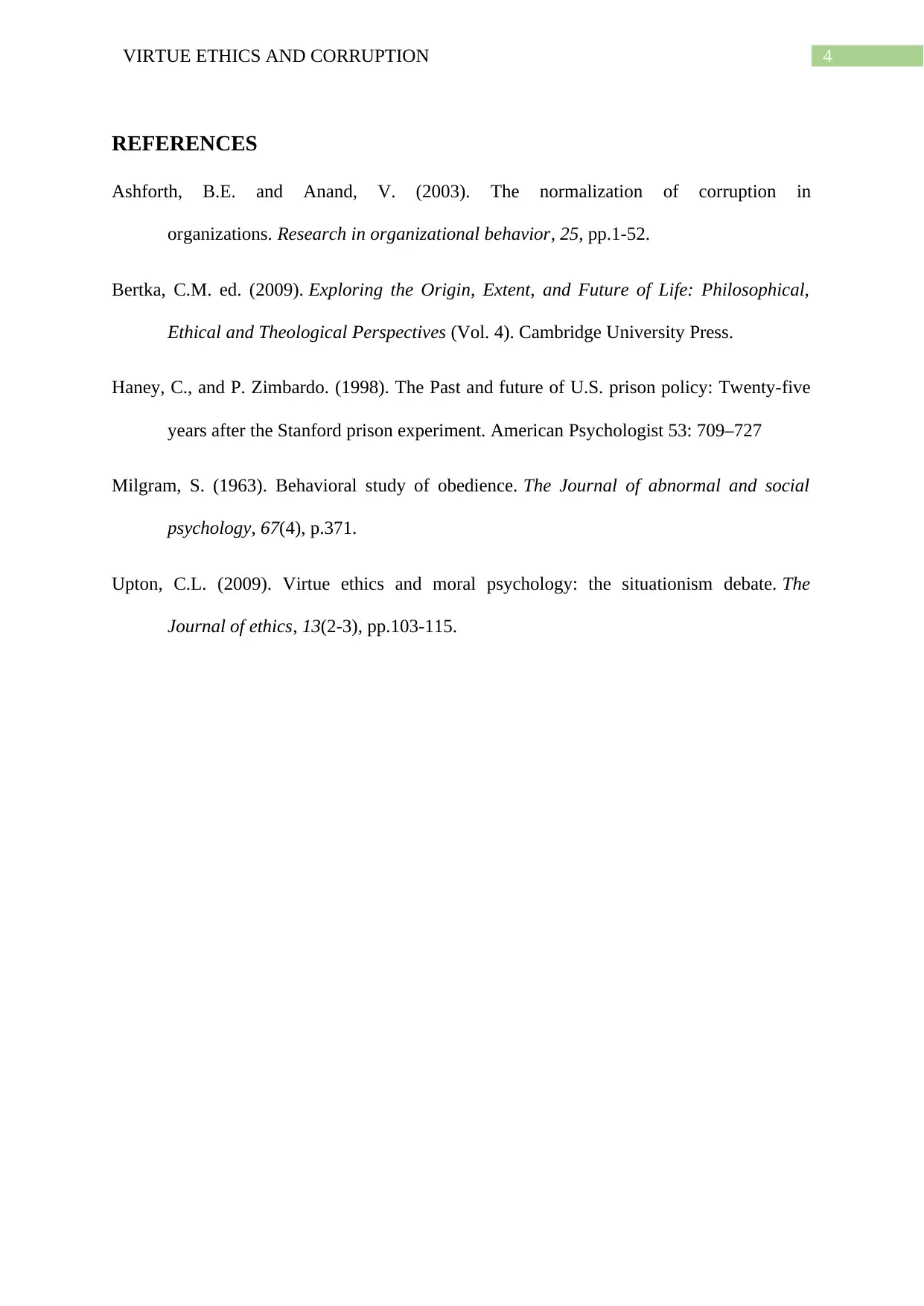
4VIRTUE ETHICS AND CORRUPTION
REFERENCES
Ashforth, B.E. and Anand, V. (2003). The normalization of corruption in
organizations. Research in organizational behavior, 25, pp.1-52.
Bertka, C.M. ed. (2009). Exploring the Origin, Extent, and Future of Life: Philosophical,
Ethical and Theological Perspectives (Vol. 4). Cambridge University Press.
Haney, C., and P. Zimbardo. (1998). The Past and future of U.S. prison policy: Twenty-five
years after the Stanford prison experiment. American Psychologist 53: 709–727
Milgram, S. (1963). Behavioral study of obedience. The Journal of abnormal and social
psychology, 67(4), p.371.
Upton, C.L. (2009). Virtue ethics and moral psychology: the situationism debate. The
Journal of ethics, 13(2-3), pp.103-115.
REFERENCES
Ashforth, B.E. and Anand, V. (2003). The normalization of corruption in
organizations. Research in organizational behavior, 25, pp.1-52.
Bertka, C.M. ed. (2009). Exploring the Origin, Extent, and Future of Life: Philosophical,
Ethical and Theological Perspectives (Vol. 4). Cambridge University Press.
Haney, C., and P. Zimbardo. (1998). The Past and future of U.S. prison policy: Twenty-five
years after the Stanford prison experiment. American Psychologist 53: 709–727
Milgram, S. (1963). Behavioral study of obedience. The Journal of abnormal and social
psychology, 67(4), p.371.
Upton, C.L. (2009). Virtue ethics and moral psychology: the situationism debate. The
Journal of ethics, 13(2-3), pp.103-115.
1 out of 5
Your All-in-One AI-Powered Toolkit for Academic Success.
+13062052269
info@desklib.com
Available 24*7 on WhatsApp / Email
![[object Object]](/_next/static/media/star-bottom.7253800d.svg)
Unlock your academic potential
© 2024 | Zucol Services PVT LTD | All rights reserved.